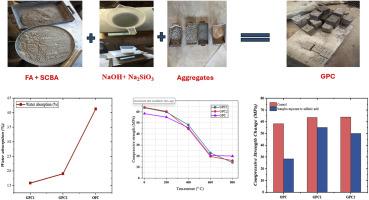Assessing the durability performance of geopolymer concrete utilizing fly ash and sugarcane bagasse ash as sustainable binders
IF 2.9
Q1 MATERIALS SCIENCE, CERAMICS
引用次数: 0
Abstract
Geopolymer or alkali-activated binders are being recognized as an eco-friendly, sustainable substitute for ordinary Portland cement (OPC). The development of high-performance concrete with improved durability and mechanical properties and the addition of environmentally friendly components is a continuous effort. Therefore, the current work examines the durability of fly ash-sugarcane bagasse ash mechanical characteristics in terms of water absorption, exposure to elevated temperatures, and acid resistance. The mechanical properties of the geopolymer concrete (GPC) and OPC concrete specimens were evaluated after being subjected to elevated temperatures of 200 °C, 400 °C, 600 °C, and 800 °C. The acid resistance was determined by submerging the concrete specimens in 3 % sulfuric acid (H2SO4). The acid resistance of the specimens was evaluated through visual inspection, weight variation, and the percentage loss in compressive strength (CR). According to the study, CR typically drops as temperature increases from ambient temperature to 800 °C. However, the rate of decline reduced as temperature increased from ambient temperature to 200 °C. Moreover, the GPC specimens showed a strength loss between 13 % and 21 % following 28 days of sulfuric acid immersion. In contrast, exposure to sulfuric acid caused a 51 % drop in strength for the OPC concrete samples.

评估利用粉煤灰和甘蔗渣灰作为可持续粘合剂的土工聚合物混凝土的耐久性能
土工聚合物或碱活性粘结剂被认为是一种环保、可持续的普通硅酸盐水泥(OPC)替代品。开发具有更好耐久性和机械性能的高性能混凝土并添加环保成分是一项持续的工作。因此,目前的工作从吸水性、暴露于高温和耐酸性等方面研究了粉煤灰-甘蔗渣灰的耐久性机械特性。在 200 ℃、400 ℃、600 ℃ 和 800 ℃ 的高温条件下,对土工聚合物混凝土(GPC)和 OPC 混凝土试样的力学性能进行了评估。将混凝土试样浸没在 3% 的硫酸(H2SO4)中测定其耐酸性。通过目测、重量变化和抗压强度(CR)损失百分比来评估试样的耐酸性。研究表明,抗压强度通常会随着温度从环境温度升高到 800 °C 而下降。然而,随着温度从环境温度升高到 200 °C,下降率有所降低。此外,GPC 试样在硫酸浸泡 28 天后,强度下降了 13% 到 21%。相比之下,暴露在硫酸中会导致 OPC 混凝土试样强度下降 51%。
本文章由计算机程序翻译,如有差异,请以英文原文为准。
求助全文
约1分钟内获得全文
求助全文
来源期刊

Open Ceramics
Materials Science-Materials Chemistry
CiteScore
4.20
自引率
0.00%
发文量
102
审稿时长
67 days
 求助内容:
求助内容: 应助结果提醒方式:
应助结果提醒方式:


